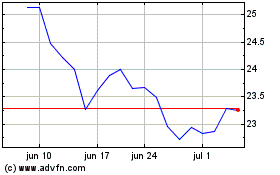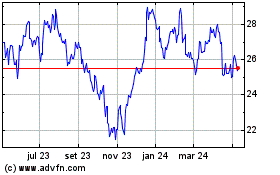ESSEN, Germany—ThyssenKrupp AG's painful restructuring from
German steel dinosaur to a world-leading industrial manufacturer is
finally starting to pay off.
Since taking the helm nearly five years ago, Chief Executive
Heinrich Hiesinger has labored to reshape what was then a staid
steel giant—one that has armed German troops for over 150
years.
ThyssenKrupp hired Mr. Hiesinger in 2011 from Siemens AG, where
he had spent nearly two decades, and tasked him with cleaning
house. The company was plagued by corruption scandals, internal
divisions and inefficiency. It was hemorrhaging cash amid a global
steel slump and suffering especially from its ill-timed expansion
of steel operations in the Americas.
"The picture at the beginning was not a very nice one," Mr.
Hiesinger said in a recent interview.
The 55-year-old engineer has since cut ThyssenKrupp's steel
production to less than 30% of sales and transformed the company
into a more diversified capital goods company. Its elevator and
escalator business is a world leader.
He has sought synergies across business areas by centralizing
controls and operating as an integrated group, rather than
disparate enterprises, as in the past.
He also has striven to reform a corporate culture that
discouraged whistleblowing about corruption and mismanagement. When
Mr. Hiesinger took over, the company was plagued by accusations
that some executives had paid bribes for contracts.
"How could it happen that our company was maneuvering itself in
such a difficult situation and nobody raised a hand or corrected it
beforehand?" Mr. Hiesinger said. "We wanted to build an
organization where hierarchy is strongly reduced, so that truth has
a chance to move up from bottom to top."
Last autumn, ThyssenKrupp posted its first annual net profit in
four years and its first dividend in three years, figures that
analysts expect to rise when the company reports its results for
fiscal-year 2015 on Thursday.
Mr. Heisinger's first success was staunching the company's cash
drain, said Christian Obst, director of equity research for steel
and metals at Baader Bank AG. "The biggest challenge going forward
is to increase free cash flow," which Mr. Obst said is "not very
satisfying so far."
Analysts widely expect the company's free cash flow to have
broken even during the fiscal year that ended Sept. 30. This is
important for a company that borrows heavily and would like to
raise its dividend payments, while increasing investments in its
capital goods businesses, said Ingo Speich, a senior portfolio
manager at Union Investment, a ThyssenKrupp investor.
Mr. Hiesinger said that when he took the reins, ThyssenKrupp was
a "low-performance company." Now, he said, it is a
"medium-performance" operation, adding: "We are definitely not
completed in our transformation."
At the center of that transformation is the company's investment
in its elevator business, which now runs even with world leader
United Technologies Corp.' Otis Elevator Company unit on its home
turf in the U.S.
"This is a business where we demonstrated now for already four
years in a row that we have the capability to really improve it,"
Mr. Hiesinger said.
Also vital to the turnaround was selling ThyssenKrupp's
Alabama-based steel-rolling and coating plant last year to a
consortium of ArcelorMittal SA and Nippon Steel & Sumitomo
Metal Corp. for $1.55 billion.
The sale improved ThyssenKrupp's balance sheet and let Mr.
Heisinger shift investment to higher-margin and more stable capital
goods businesses, said Seth Rosenfeld, an analyst at Jefferies
International Ltd.
Aside from elevators, ThyssenKrupp's capital goods businesses
include a unit that supplies the auto industry with parts such as
electrical-steering systems and engine components. Another unit
builds complex systems including production facilities for
industrial customers and advanced submarines.
Some investors, including Union, have urged ThyssenKrupp to sell
its marine business. Mr. Speich said that the unit was profitable
but in a risky sector, so selling it would only improve the
company's overall multiple.
Mr. Hiesinger said he still wants to sell the last part of
ThyssenKrupp's U.S. steel operations, a plant in Brazil, when
market conditions improve.
Unloading the company's storied European steel business, on
which ThyssenKrupp was built, would be tougher.
"We don't deny there is a structural weakness in the European
steel market," Mr. Hiesinger said. "But to be honest," he added,
"it's unlikely that you can sell" the company's European steel
unit. He noted that the division's earning grew over the past year
and it was "cash contributing."
Despite Mr. Heisinger's efforts, ThyssenKrupp's stock price is
little changed from one year ago and shareholders' patience is
uncertain.
Swedish activist investor Cevian Capital Partners owns a 16%
stake and since January has held one of the 20 seats on
ThyssenKrupp's supervisory board. The Swedish investment fund is
one of the few activist investors to sit on the board of a German
company and analysts have long speculated the firm would like to
engineer a breakup of ThyssenKrupp.
Such a move could set up a clash on the supervisory board with
representatives of the Krupp family foundation, which holds 23% and
two supervisory board seats. The foundation, which lost one board
seat and veto power in 2013 after sitting out a capital increase,
still abides by its charter to keep the company's structure
intact.
Cevian and the foundation declined to comment. Cevian in the
past has voiced public support for Mr. Hiesinger and his
strategy.
Write to Christopher Alessi at christopher.alessi@wsj.com
Access Investor Kit for "Siemens AG"
Visit
http://www.companyspotlight.com/partner?cp_code=P479&isin=DE0007236101
Access Investor Kit for "ThyssenKrupp AG"
Visit
http://www.companyspotlight.com/partner?cp_code=P479&isin=DE0007500001
Subscribe to WSJ: http://online.wsj.com?mod=djnwires
(END) Dow Jones Newswires
November 17, 2015 12:05 ET (17:05 GMT)
Copyright (c) 2015 Dow Jones & Company, Inc.
Arcelor Mittal (NYSE:MT)
Gráfico Histórico do Ativo
De Mar 2024 até Abr 2024

Arcelor Mittal (NYSE:MT)
Gráfico Histórico do Ativo
De Abr 2023 até Abr 2024
